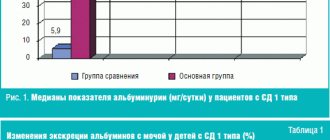Diagnosis and treatment of tics are one of the pressing problems of pediatric neurology. Tics (from the French “tic” - convulsive twitching) belong to hyperkinesis and are characterized by violent movements that manifest themselves in various muscle groups, most often in the facial muscles. Chronic tics are a more severe variant of the disease, in which, according to ICD-10 criteria, hyperkinesis occurs many times during the day, almost daily or intermittently, for 1 year or more.
Manifestations of tics in 1663 were described by W. Drage (cited by A. Lis [1]). Until the end of the 19th century, tics were considered as manifestations of one of the variants of chorea. The first clinical description of tics was made by Trousseau in 1873, although he also considered them as an incomplete variant of chorea (cited by H. Rickards [2]). JM Charkot considered tics as a mental illness masquerading as a bodily form (cited from [3]), and instructed his student G. Gilles de la Tourette to study the group of hyperkinesis in more detail. In 1884-1885. the latter noted that tics are characterized by onset in childhood, occur more often in men, have a wave-like course, and more often affect the face and hands (cited by A. Lis [1]).
Tics are a common disease, especially in childhood. Thus, S. Amiri et al. [4] found vocal tics in 3.2% of Iranian schoolchildren and motor tics in 7.3%. According to L. Scahill et al. [5], transient tics occur in 20% of children. On average, 3-4% of children in the population suffer from a chronic form of the disorder [6]. According to E. Cubo et al. [7], chronic tics occur in Spain in 6% of children, while Brazilian authors H. Alves and E. Quagliato [8] provide information about the occurrence of this disorder in 2.3% of cases, and S. Yang et al. [9] note this pathology in Chinese children in 1.2% of cases. D. Cath et al. [10] believe that in 90% of cases, tics begin between the ages of 3 and 15 years, and M. Robertson [11] limits this time to 4-8 years. According to our observations [12], the average age of onset of tics is 6.7±2.1 years. Moreover, the average age of onset of transient tics is 7.9±1.9 years, and the average age of onset of chronic tics is 5.8±1.6 years, which indicates that an earlier age of onset of tics is a prognostically unfavorable sign.
Genetic and immune mechanisms, perinatal pathology, as well as psychosocial factors play a role in the pathogenesis of tics.
Tics are a coordinated display of normal motor activity. A distinctive feature is their irresistible nature.
In most cases, tics are combined with comorbid pathology. Often it is the concomitant pathology, and not the hyperkinesis itself, that is the most maladaptive manifestation of the disease. So, according to V.P. Zykova et al. [13], most patients with a history of tics had delayed motor and speech development. According to the results of a neuropsychological study, the most typical for children with tics in these cases are disturbances in the dynamic praxis of attention, speech, memory, writing and auditory-motor coordination. Moreover, the severity of such disorders correlates with the severity and prevalence of hyperkinesis.
The comorbidity of tics and attention deficit hyperactivity disorder (ADHD) is generally accepted. According to our data [12], ADHD occurs in 48% of children with tics. But if in children with transient tics ADHD is diagnosed in 27.5% of cases, then in children with chronic tics - in 58.4%.
The noted features of tics, as well as their resistance to therapy, determine the relevance of this problem for pediatric neurology, especially with regard to the need to develop new approaches to the treatment of this disorder.
The purpose of this study is to clarify the severity of cognitive impairment in children with chronic tics and to evaluate the effectiveness of the use of the drug Cortexin as part of complex therapy.
Material and methods
The main group included 50 children aged 6-8 years with chronic motor tics. The comparison group consisted of 30 children with transient tics aged 6-8 years. The control group included 40 children of the same age without tics and other neurological and mental disorders.
The diagnostic examination included a clinical assessment of the manifestations of tics, a neurological examination, electroencephalography, and a psychological study. When assessing anamnestic data, we took into account hereditary history of tics, troubles in the perinatal period, and family and social history.
Mean tic frequency was calculated using the 5-point tic frequency scale from the Tourette' Syndrome Global Scale (TSGS). The severity of concomitant clinical manifestations of ADHD was assessed using the SNAP-IV scale. To determine the severity of asthenic disorders, the subjective asthenia rating scale (MFI-20) was used.
To study auditory-verbal memory, the memorization method according to A.R. was used. Luria. The level of attention was assessed using the psychophysiological test TOVA (The Test of Variables of Attention), based on the presentation of visual stimuli.
Diagnostic electroencephalography (EEG) was performed on all examined children using a 21-channel digital encephalograph. Routine (visual) analysis of the curve consisted of assessing the general functional state of the brain, the level of maturity of the bioelectrical activity of the brain and the correspondence of its nature to the patient’s age; assessing the severity of EEG changes and localization of pathological changes. EEG power spectra were analyzed, with special attention paid to the absolute power of alpha and theta rhythms and the distribution gradient along the convex. Qualitative parameters of rhythms were assessed: regularity, wave features, modulation.
To carry out the therapeutic part of the study, the main group of children with chronic tics was divided into two subgroups. Children from subgroup 1 (20 people with chronic tics) received L.P. as part of an open 8-week study. Phenibut (aminophenylbutyric acid) for 60 days at a dose of 500 mg/day (with a gradual increase and gradual withdrawal of the dose) as monotherapy. This drug is traditionally used to treat tics in children [14]. Children from subgroup 2 (30 people with chronic tics), in addition to the above-described course of L.P. Phenibut, starting from the 1st day of treatment, L.P. was given. Cortexin at a dose of 10 mg/day, 10 intramuscular injections every other day. Thus, the duration of taking L.P. Cortexin was 20 days, L.P. Phenibut – 60 days. Treatment was carried out on an outpatient basis. The effectiveness of treatment was assessed on days 60–65.
It should be noted that, according to the inclusion criteria, during the study period and 3 months before inclusion in the study, patients did not receive other drugs acting on the central nervous system.
results
The average age in the group of children with chronic tics was 6.8±0.8 years. In this group there were 43 (86.0%) boys and 7 (14.0%) girls.
The average age in the group of children with transient tics was 7.2±0.9 years. The number of boys in this group was 23 (76.7%), and girls - 7 (23.3%).
The most common hyperkinesis was blinking, it was observed in 36 (72.0%) children, eyebrow raising - in 12 (24.0%), forehead frowning - in 10 (20.7%). In 31 (62.0%) cases, the patient had several tics at once.
The average frequency of tics in the group of children with transient tics was 3.4±1.5 points, in the group of children with chronic tics - 3.5±1.3 points. Thus, there were no significant differences in the frequency of hyperkinesis in the study groups ( p
>0,05).
33 (66.0%) children with chronic tics and 8 (26.7%) children with transient tics had complaints of fatigue, general weakness, exhaustion, lethargy, and daytime sleepiness. It should be noted that the corresponding complaints arose during the school day and did not go away after rest. In the group of patients with transient tics, the average asthenia indicators were close to normal. The greatest severity of asthenia was noted in the subscales “general asthenia” and “mental asthenia” in the group of patients with chronic tics.
There were no significant differences between short-term memory indicators in the study groups. Indicators of long-term memory in children with chronic tics were significantly lower than in the control group and the group of children with transient tics (Table 1).
Table 1. Clinical and psychological indicators in the study groups Note. * — p<0.05 — significance of differences compared with the corresponding indicator in the control group; # — p<0.05 — significant differences compared to the group of children with transient tics.
The results of the TOVA test showed that children with tics had significantly reduced indicators of attention (omissions of reactions), more pronounced in the second half of the test. At the same time, in children with chronic tics the level of inattention was significantly higher. In addition, children with tics had a higher level of false alarms (erroneous button presses), associated with impulsivity, compared to children from the control group, while the observed changes increased significantly in the second half of the test. It should be noted that the second indicator turned out to be significantly higher in children with transient tics (Fig. 1).
Rice. 1. TOVA test scores in children with transient and chronic tics before treatment.
Analysis of EEG of patients in the study groups (Fig. 2)
Rice.
2. EEG power spectra in children with transient and chronic tics before treatment. showed that in the group with transient tics, the power of the theta range in the occipital-parietal leads of both hemispheres is statistically significantly greater ( p
<0.05) both compared to healthy children and compared to children with chronic tics (
p
<0.05). 05). Many children in this group at 6-7 years of age show subdominance of theta activity in the occipital leads of both hemispheres, while in children with chronic tics there are single (less often group) theta waves.
When analyzing the alpha range in the occipital leads in children with chronic tics, a statistically significant ( p
<0.05) decrease in power compared to healthy children (see Fig. 2). One can also note a higher amplitude of the alpha rhythm in the posterior parts of both hemispheres compared to healthy children and children with transient tics. The majority of subjects in this group recorded higher values of the peak frequency of the alpha rhythm (9-10 counts/s) compared to the indicators of the group of children with transient tics (7-7.5 counts/s).
Children with transient tics showed a statistically significant decrease in alpha band power compared to healthy children and children with chronic tics ( p
<0.05) (see Fig. 2). In most children, the amplitude of the alpha rhythm is not increased compared to healthy children.
In the frontotemporal leads of both hemispheres in children with chronic tics, a statistically significant ( p
<0.05) increase in alpha range power compared to healthy children. Many have noted a tendency for alpha activity to spread to the anterior parts of the cerebral cortex and episodes of rhythm synchronization in the alpha range.
In subgroup 1, after treatment, chronic tics decreased in 12 (60.0%) patients. The average frequency of tics on a 5-point TSGS scale after the course was 2.7±1.5 points (with a maximum frequency of 5 points), which indicates a significant improvement ( p
<0.05) (Table 2).
Table 2. Average clinical and psychological indicators in subgroups before and after treatment Note.
# — p<0.05 — significance of differences compared with the corresponding indicator before treatment; ## — p<0.01 — significance of differences compared with the corresponding indicator before treatment; * - p<0.05 - significance of differences compared with the corresponding indicator in group 1. After the course of treatment, asthenic symptoms decreased. No significant changes in memory indicators were recorded (see Table 2). A repeated study using the TOVA test after treatment revealed a statistically significant decrease in inattention and false alarms in the second half of the test (Fig. 3).
Rice. 3. TOVA test scores after treatment in subgroups of children with chronic tics.
According to the EEG analysis, after treatment in subgroup 1, the power of alpha waves in the occipital leads of both hemispheres statistically significantly increased compared to the indicators before treatment ( p
<0.05) (Fig. 4).
Rice.
4. EEG power spectra after treatment in subgroups of children with chronic tics. One can also note in many patients a decrease in amplitude in the occipital leads, a decrease in the representation of alpha and theta waves in the anterior parts of the cerebral cortex (see Fig. 4). Tolerability of therapy can be described as good. A side effect in the form of transient daytime sleepiness was noted in 2 children; in another case, parents noted an increase in physical activity. These undesirable symptoms appeared at the beginning of the course and disappeared after 2 weeks during treatment. It should be noted that these phenomena did not lead to interruption of therapy. No other side effects were identified.
In subgroup 2, after completion of treatment L.P. Phenibut in combination with L.P. Cortexin, a decrease in chronic tics was noted in 25 (83.3%) patients suffering from this disorder. The average frequency of tics on the TSGS scale after the course was 2.0±1.4 points (with a maximum frequency of 5 points), which indicates a significant improvement ( p
<0.01). In addition, a pronounced decrease in asthenic symptoms should be noted (see Table 2).
The results of a repeated psychological study showed a pronounced improvement in memory indicators: after the course of treatment, the volume of words and the strength of mnestic traces when testing auditory verbal memory significantly increased (see Table 2).
A repeated psychophysiological study (TOVA test) after the course of treatment in subgroup 2 revealed a pronounced decrease in inattention and false alarms, especially in the second half of the test, both compared to the indicators before treatment and compared to the indicators of subgroup 1 (see Fig. 13).
When analyzing the EEG data of patients in subgroup 2 after the course of treatment, we also saw a statistically significant ( p
<0.05) increase in the power of alpha range waves in the occipital leads of both hemispheres with a significant decrease in power in the frontotemporal regions (
p
<0.05).
In the frontotemporal regions of the cerebral cortex, a statistically significant decrease in power was noted both in comparison with the indicators before treatment ( p
<0.05), and when comparing the power of this range with the indicators of subgroup 1 (Fig. 4). In addition, one can note an increase in the gradient between the frontal and occipital regions of both hemispheres. Upon visual assessment, the following positive changes were noted: a decrease in the amplitude of the background EEG, a decrease in episodes of rhythm synchronization in the alpha range, a decrease in pointed waves and polyphasic potentials in the occipital leads.
Tolerability of therapy can be described as good. In 2 cases, an increase in motor activity was recorded. These undesirable symptoms appeared at the beginning of the course and disappeared after 2 weeks during treatment. It should be noted that these manifestations did not lead to interruption of therapy. No other side effects were identified.
Does a child's cognitive impairment affect his or her lifespan?
Unfortunately, there is a correlation between life expectancy and cognitive impairment. There is no single reason that a child with cognitive impairment may have a shorter lifespan. Researchers suspect that stress, combined with the general condition of the body affected by cognitive impairment, may be a factor.
Just because there is a connection between cognitive impairment and decreased life expectancy does not mean that the child will have a reduced life expectancy, however. Many people with cerebral palsy who have cognitive impairment live a normal life expectancy provided the right types of medical care and support are in place.
Obviously, a child's life expectancy is a major concern for parents. The best way a parent can help prolong a child's life is to keep a close eye on his or her health—if the issue seems minor, don't hesitate to have it checked by a doctor, who can keep parents informed about what's going on even when the child can't.


